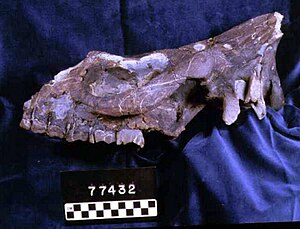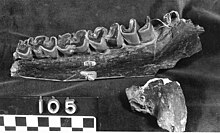Diceratherium
| Diceratherium | ||||||||||||
|---|---|---|---|---|---|---|---|---|---|---|---|---|

Skull of Diceratherium |
||||||||||||
| Temporal occurrence | ||||||||||||
| Early Oligocene to Middle Miocene | ||||||||||||
| 33 to 14 million years | ||||||||||||
| Locations | ||||||||||||
| Systematics | ||||||||||||
|
||||||||||||
| Scientific name | ||||||||||||
| Diceratherium | ||||||||||||
| Marsh , 1875 | ||||||||||||
Diceratherium is an extinct genus of rhinos thatlived in North Americafrom the Early Oligocene around 33 million years ago to the Middle Miocene 14 million years ago. It was the first rhinoceros representative with clearly developed horns. Here had diceratherium two horns, but occurred only in males, and in contrast to today's two-horned rhinos were paired on the nose. The rhinoceros representative lived in partly open landscapes.
features
Diceratherium comprised medium-sized to very large rhino representatives and was the largest land mammal of its time in North America until the arrival of the early proboscis . The medium-sized species could reach a head-to-trunk length of 236 cm and a shoulder height of about 121 cm, the largest Representatives were considerably larger and exceeded the medium-sized species in all lengths by 30%.
The skull was 42 to 56 cm long and was very elongated and flat. The frontal bone was clearly steepened in the rear area, the occiput had a more rectangular shape. The nasal bone showed clear curvatures both laterally and longitudinally and was very elongated. At the front tip there were two adjacent, pearl-like roughened surfaces that indicate the position of the horns. These stood side by side in pairs, in contrast to the tandem horns of today's two-horned rhinos. The nasal bone had no connection with the intermaxillary bone , but lay far above, the interior of the nose was relatively large.
The lower jaw measured between 35 and 45 cm in length and had a robust bone body. The symphysis was also strong, could be up to 10 cm long and extends to the third premolar . The bite was lower against the predecessor of diceratherium , subhyracodon slightly reduced and included the following dental formula : . The inner incisors (I1) had a nail-like, small shape, while the outer ones (I2) were conically long and angled forward with a length of up to 8.7 cm, so that they resembled small tusks . The canine was missing and there was a diastema of up to 7 cm in length to the rear dentition . With the exception of the first, the premolars were clearly molarized and thus resembled the molars . All posterior molars were slightly high crowned ( hypsodont ).
The postcranial skeleton is known from several complete skeletal finds. The spine consisted of 7 cervical, 19 thoracic, 5 lumbar, 3 sacrum and 21 tail vertebrae. In particular, the spinous processes on the thoracic vertebrae were significantly more massive than in the closely related subhyracodon . The body was generally strong and had long, slender limbs, and the femur was up to 37 cm long. The metapodia were comparatively short. Arms and legs each ended in three rays with a strongly shaped central ray.
Fossil finds
Diceratherium is known exclusively from North America and is found predominantly in the High Plains and the Northwest of the USA . A complete skeleton was discovered in the Protaceras Bed near the White River in South Dakota as early as 1892 , only missing part of the forefoot, a few ribs and the sternum . Other finds, especially skulls, but also postcranial skeletal elements, come from the Brule Formation , also in South Dakota. All of these finds are assigned to the medium-sized species D. tridactylum . A complete skull and limbs of D. armatum come from the John Day Formation in Oregon ( John Day Fossil Beds National Monument ). Very abundant material from D. niobrarense came to light from the lower Marsland Formation in Nebraska and is one of the most recent finds at an age of 14 million years. Remains of the very large species D. radtkei , including a lower jaw and several skull fragments, have been identified from the Cabbage Patch Beds in western Montana , among other places .
Paleobiology
The more or less high-crowned teeth suggest a certain specialization in hard plant food. For some sites with remains of Diaceratherium , especially in Oregon, only lightly forested, partly wet meadow steppes are being reconstructed. These open landscapes emerged in the transition to the Miocene through climatic changes towards cooler climatic conditions. Towards the middle Miocene, dry, semi-desert steppes developed at these sites.
A certain sexual dimorphism can be found in the skull structure of Diaceratherium , which occurs only rarely in today's rhinos. Male animals generally have more robust skulls with protruding cheekbones . The nasal bone is also generally stronger and thicker here, which increases with age. The skulls of female animals are slimmer, the nasal bone is longer and narrower and has no rough surfaces. It is possible that Diceratherium cows had no horns in general.
Despite the numerous finds, hardly any pathological changes are known to date . Disease- related curvatures due to osteoarthritis were found on only one of more than 60 thigh bones known from the Marsland Formation and caused a shaft bend of around 30 °, with the knee also being impaired.
Systematics
|
Internal systematics of the North American rhinos according to Prothero 2005
|
The genus Diceratherium belongs to the rhinoceros family and is part of the subfamily Diceratheriinae . This subfamily, which is very ancient in phylogeny , is divided into two tribes , with Diceratherium belonging to the Diceratheriini tribe, which faces the Trigoniadini tribe and is characterized by two paired horns. The forerunner of this genus of rhinoceros was most likely Subhyracodon , from which it developed continuously. Another relative is the Skinneroceras , which was only described in 2005 .
Today five species are recognized that belong to Diceratherium :
- D. annectens ( Marsh , 1873)
- D. armatum Marsh , 1875
- D. niobrarense Peterson , 1906
- D. radtkei Prothero & Rasmussen , 2008
- D. tridactylum ( Osborn , 1893)
The first finds were of Diceratherium were originally referred to the genus Rhinoceros by Othniel Charles Marsh in 1870 and 1873 , it was not until 1875 that the same author first described it on the basis of finds near the John Day River in Oregon; it was the first rhinoceros with distinct horn formations that was described from North America. The scientific name is made up of the Greek words δι (prefix di- "two-"), κέρας ( kéras "horn") and θηρίον ( thērion "animal") and refers to the paired nasal horns.
Initially, it was often confused with Aceratherium , an actually hornless rhinoceros from the Aceratheriinae group , which lived largely in the Miocene but was much more advanced. Henry Fairfield Osborn first described the complete skeleton from the White River in South Dakota as Aceratherium tridactylum , the addition of the species tridactylum being due to the idea at the time that all early Miocene rhinos actually had four-pointed forefeet. He later revised his mind. There was also frequent confusion with Menoceras , an animal from the group of Rhinocerotinae that also has paired nasal horns . However, Menoceras has much more modern features, such as a shorter skull, more reduced dentition, and more intricately folded enamel on the chewing surfaces of the molars. The structure of the nasal bone, with its clearly rounded horn attachment surfaces, shows differences to Diceratherium with its rather elongated horn attachments .
Diceratherium was first detected in the Early Oligocene around 33 million years ago (locally stratigraphically assigned to the Early Whitneyum ) and emerged from Subhyracodon . The oldest species was the small D. tridactylum . In the later Oligocene to the Miocene the huge D. radtkei developed , which is only known from a few finds. The rhinoceros genus died out in the Middle Miocene about 14 million years ago (locally stratigraphically Late Arikareeum to Early Hemingfordium ), the youngest species was D. niobrarense . With the extinction of Diceratherium , the branch of the Diceratheriini also became extinct.
Web links
Individual evidence
- ^ Donald R. Prothero: Fifty million years of rhinoceros evolution. In: OA Ryder (Ed.): Rhinoceros biology and conservation: Proceedings of an international conference, San Diego, USA Zoological Society, San Diego, 1993, pp. 82-91.
- ↑ a b c d Henry Fairfield Osborn: The extinct rhinoceroses. Memoirs of the American Museum of Natural History 1 (3), 1898, pp. 75-164.
- ↑ a b c d e Donald R. Prothero and Donald L. Rasmussen: New giant rhinoceros from the Arikareean (Oligocene-Miocene) of Montana; South Dakota and Wyoming. In: Spencer George Lucas et al. (Ed.): Neogene Mammals. New Mexico Museum of Natural History and Science Bulletin 44, 2008, pp. 323-329.
- ^ A b c William Berryman Scott: Part V: Perissodactyla. In: William Berryman Scott, Glenn Lowell Jepsen and Albert Elmer Wood (Eds.): The Mammalian Fauna of the White River Oligocene. The American Philosophical Society, Philadelphia, Pennsylvania, 1941, pp. 775-821.
- ↑ a b c d e f g h i Donald R. Prothero: The evolution of North American rhinoceroses. Cambridge University Press, 2005, pp. 1-219.
- ↑ a b Gregory J. Retallack: Late Oligocene bunch grassland and early Miocene sod grassland paleosols from central Oregon, USA. Palaeogeography, Palaeoclimatology, Palaeoecology 207, 2004, pp. 203-237.
- ^ A b Henry Fairfield Osborn: Aceratherium tridactylum from the Lower Miocene of Dakota. Bulletin American Museum of Natural History 5, 1893, pp. 85-86.
- ^ A b Robert M. Stecher, C. Bertrand Schultz and Lloyd G. Tanner: A Middle Miocene Rhinoceros Quarry in Morrill County, Nebraska (with Notes on Hip Disease in Diceratherium). Bulletin of The University of Nebraska State Museum 4 (7), 1962, pp. 100-111.
- ^ Othniel Charles Marsh Notice of new tertiary mammals IV. American Journal of Science (3) 9, 1875, pp. 239-251.
- ↑ Donald R. Prothero, Earl Manning and C. Bruce Hanson: The phylogeny of the rhinocerotoidea (Mammalia, Perissodactyla). Zoological Journal of the Linnean Society 87, 1986, pp. 341-366.



